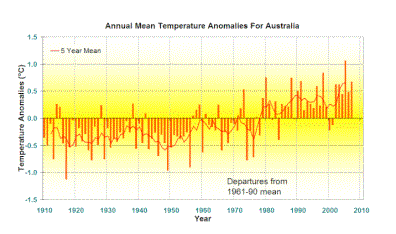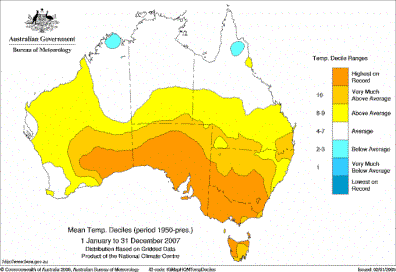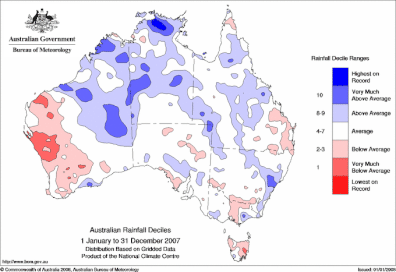Annual Australian Climate Statement 2007
Bureau of Meteorology
Annual Australian Climate Statement 2007
Overview
* Australian annual mean temperature for 2007 was 6th warmest on record (0.67°C above normal).
* Australian annual mean maximum temperature for 2007 was 0.73°C above normal and annual mean minimum temperature 0.61°C above normal.
* Highest on record annual mean and maximum temperatures across much of the south.
* Warmest year on record for Murray Darling Basin, South Australia, New South Wales and Victoria.
* Australian annual mean rainfall slightly more than average (25 mm above normal).
* Average to above
average annual rainfall across northern and central
Australia, average to below average annual rainfall in the
southwest, mixed results in the remainder.
* Long-term
droughts persist in the far southwest and southeast.
Record warmth across the south
Data collected by the Bureau of Meteorology indicate that Australia's annual mean temperature for 2007 was 0.67°C above the standard 1961-90 average, making it the nation's 6th warmest year since comparable records began in 1910. Mean temperatures were above average across Australia during every month except June and December.
Cool temperatures during June were a result of highly unusual heavy rains over northern Australia, and a series of low pressure systems, including that which caused extensive flooding around Newcastle. Record high temperatures were observed in the west during February, in the east during May, and across parts of the south during November. Overall, annual mean temperatures were close to average across the north, while most of the south recorded its warmest year on record. The Murray Darling Basin, South Australia, New South Wales and Victoria all recorded their warmest years on record.

(Above) Australian annual mean temperature anomalies (from 1961-90 average) since 1910 and (below) 2007 mean temperatures compared against historical temperature records.

Australia has now recorded a warmer-than-average year for 16 of the past 18 years. This pattern is not surprising given that Australia's climate is warming in line with the rest of the globe. The World Meteorological Organization (WMO) stated on 13 December 2007 that the global mean temperature for 2007 was about 0.41°C above average, making 2007 the globe's 7th warmest year since records commenced in 1850. There is an overwhelming view from climate scientists contributing to the assessments of the Intergovernmental Panel on Climate Change (IPCC) that most of the global and Australian warming over the last 50 years is directly attributable to human emissions of greenhouse gases.
A late-developing La Niña fails to deliver
Based on preliminary data, the Australian mean rainfall total for 2007 was 497 mm, slightly more than the long-term average of 472 mm. La Niña conditions developed in the tropical Pacific Ocean during 2007. Such conditions are usually, but not always, associated with above-average rainfall across much of Australia. However, the 2007 La Niña event was slow to develop and its influence during winter and spring was confounded by a counter influence from the Indian Ocean.
Despite some promising rains during the first half of the year, July to October was particularly dry across the south, with widespread above-average rainfall not returning until November. Overall, rainfall was average to above average across northern and central Australia and average to below average in the southwest, with mixed outcomes in the southeast. Patchy rainfall across southern Australia means that long-term droughts persist in the far southwest and in the southeast, including the Murray Darling Basin, all of Victoria and northern Tasmania.

(Above) Australian annual mean rainfall (mm) since 1900 and (below) 2007 rainfall compared against historical rainfall records.

Southeast Australia has now missed out on the equivalent of an average year's rainfall over the past 11 years, making the current drought one of Australia's most severe on record - comparable in terms of rainfall deficiencies with the Federation drought. However, the latest drought is notable for its record high temperatures and record low inflows to water storages.
Climate change projections show a general drying trend across southern Australia over the decades ahead. However, it remains unclear how much of the current rainfall decline in the southeast can be attributed to human-induced climate change.
A century of safeguarding the nation's climate record
Australian mean temperatures are calculated from a nation-wide network of about 100 high-quality, non-urban, observing stations. Extensive data rehabilitation has been undertaken to ensure that the temperature records from these sites have not been compromised by changes in site location, urbanisation, exposure or instrumentation over time. Australia's area-averaged rainfall is calculated from a network of around 5000 rainfall stations, most of which are staffed by volunteer observers.
Since 1 January 1908, the Bureau of Meteorology has been responsible for collecting, managing and safeguarding Australia's climate record. The national climate archive allows data recorded today to be placed in historical context and helps Australians manage the risks associated with both short-term and long-term climate change.
ENDS
Latest World News | Top World News | World Digest | Archives | RSS


 UN High Commissioner for Human Rights: Türk Welcomes 2nd International Decade For People Of African Descent, Calls For Bold Action To Deliver Real Change
UN High Commissioner for Human Rights: Türk Welcomes 2nd International Decade For People Of African Descent, Calls For Bold Action To Deliver Real Change John P. Ruehl, IMI: What Is Driving State-Sponsored Attacks On Citizens Abroad?
John P. Ruehl, IMI: What Is Driving State-Sponsored Attacks On Citizens Abroad? Department of Conservation: Cook Islands’ Atoll Officially Rat Free
Department of Conservation: Cook Islands’ Atoll Officially Rat Free Médecins Sans Frontières: MSF Ends Operation Of Its Search And Rescue Vessel With A Commitment To Return To Central Mediterranean Sea
Médecins Sans Frontières: MSF Ends Operation Of Its Search And Rescue Vessel With A Commitment To Return To Central Mediterranean Sea People with Disability Australia: Government Response To ADHD Senate Inquiry Falls Short
People with Disability Australia: Government Response To ADHD Senate Inquiry Falls Short Access Now: From Prison Sentences For Online Posts To Malicious Spyware Attacks, This Year’s IGF Host Is Entrenched In Abuse
Access Now: From Prison Sentences For Online Posts To Malicious Spyware Attacks, This Year’s IGF Host Is Entrenched In Abuse